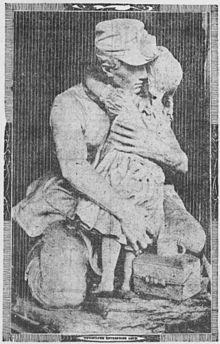
Daniel Chester French was an American sculptor of the late nineteenth and early twentieth centuries. He is best known for his 1874 sculpture The Minute Man in Concord, Massachusetts, and his 1920 monumental statue of Abraham Lincoln in the Lincoln Memorial in Washington, D.C.
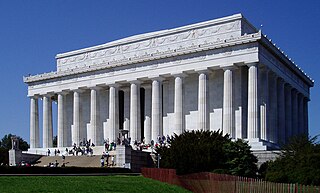
Henry Bacon was an American Beaux-Arts architect who oversaw the engineering and design of the Lincoln Memorial in Washington, D.C., built between 1915 and 1922, which was his final project before his 1924 death.

Lorado Zadok Taft was an American sculptor, writer and educator. Part of the American Renaissance movement, his monumental pieces include, Fountain of Time, Spirit of the Great Lakes, and The Eternal Indian. His 1903 book, The History of American Sculpture, was the first survey of the subject and stood for decades as the standard reference. He has been credited with helping to advance the status of women as sculptors.
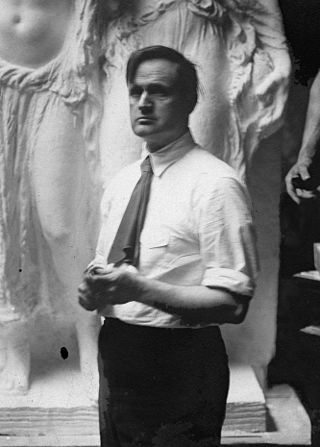
James Earle Fraser was an American sculptor during the first half of the 20th century. His work is integral to many of Washington, D.C.'s most iconic structures.

Bela Lyon Pratt was an American sculptor from Connecticut.

Carl Augustus Heber was an American sculptor noted for his public monuments.

Fountain of Time, or simply Time, is a sculpture by Lorado Taft, measuring 126 feet 10 inches (38.66 m) in length, situated at the western edge of the Midway Plaisance within Washington Park in Chicago, Illinois, in the United States. The sculpture is inspired by Henry Austin Dobson's poem "Paradox of Time". Its 100 figures passing before Father Time were created as a monument to the 100 years of peace between the United States and the United Kingdom following the Treaty of Ghent in 1814. Father Time faces the 100 from across a water basin. The fountain's water was turned on in 1920, and the sculpture was dedicated in 1922. It is a contributing structure to the Washington Park United States Registered Historic District, which is a National Register of Historic Places listing.

Nellie Verne Walker, was an American sculptor best known for her statue of James Harlan formerly in the National Statuary Hall Collection in the United States Capitol, Washington D.C.
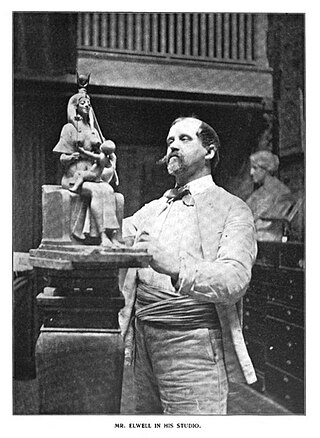
Francis Edwin Elwell was an American sculptor, teacher, and author.

Andrew O'Connor was an American-Irish sculptor whose work is represented in museums in America, Ireland, Britain and France.
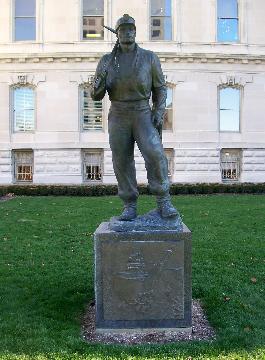
Coal Miner is a public artwork by Polish American artist John J. Szaton (1907–1966) which is located in two US State capitals; the original, commissioned in 1963 in Springfield, Illinois, as well as a copy on the west lawn of the Indiana State House in Indianapolis The statues commemorate coal miners who had lost their lives in those states' mining industry. The 7-foot (2.1 m) tall statue rests on a 3-foot (0.91 m) square, granite base supported by a cement foundation that is 4–6 inches (100–150 mm) thick.
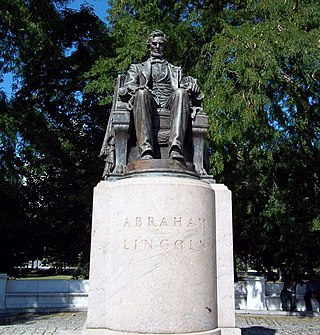
Abraham Lincoln: The Head of State is a 9-foot (2.7 m) tall bronze statue of Abraham Lincoln in Grant Park, in Chicago. Created by Augustus Saint-Gaudens and completed by his workshop in 1908, it was intended by the artist to evoke the loneliness and burden of command felt by Lincoln during his presidency. The sculpture depicts a contemplative Lincoln seated in a chair, and gazing down into the distance. The sculpture is set upon a pedestal and a 150-foot (46 m) wide exedra designed by architect Stanford White.
Leonard Crunelle was a French-born American sculptor especially known for his sculptures of children. Crunelle immigrated with his family to the United States and worked as a coal miner in Decatur, Illinois. Lorado Taft discovered him as a youth and brought him to Chicago where he was an apprentice to the sculptors decorating the 1893 World's Fair Horticultural Exhibit. He studied at the Art Institute of Chicago with Taft.

Eternal Silence, alternatively known as the Dexter Graves Monument or the Statue of Death, is a monument in Chicago's Graceland Cemetery and features a bronze sculpture of a hooded and draped figure set upon, and backdropped by, black granite. It was created by American sculptor Lorado Taft in 1909.

Frederick Cleveland Hibbard was an American sculptor based in Chicago. Hibbard is best remembered for his Civil War memorials, produced to commemorate both the Union and Confederate causes.
George Etienne Ganiere was an American sculptor born in Chicago, Illinois. There he studied at the Art Institute of Chicago where he eventually became an instructor and then the head of the Sculpture Department.
John J. Szaton was a Polish-American sculptor born in 1907 in Ludlow, Massachusetts.

General John Logan Memorial, also known as the John Alexander Logan Monument, is an outdoor bronze sculpture commemorating John A. Logan by sculptors Augustus Saint-Gaudens and Alexander Phimister Proctor, in a setting by architect Stanford White. Installed in Chicago's Grant Park, in the U.S. state of Illinois, the statue and pedestal sit atop a memorial mound, with a ceremonial stairway leading to the summit.

The Ulysses S. Grant Monument is a presidential memorial in Chicago, honoring American Civil War general and 18th President of the United States Ulysses S. Grant. Located in Lincoln Park, the statue was commissioned shortly after the president's death in 1885 and was completed in 1891. Several artists submitted sketches, and Louis Rebisso was selected to design the statue, with a granite pedestal suggested by William Le Baron Jenney. At the time of its completion, the monument was the largest bronze statue cast in the United States, and over 250,000 people were present at the dedication.
















